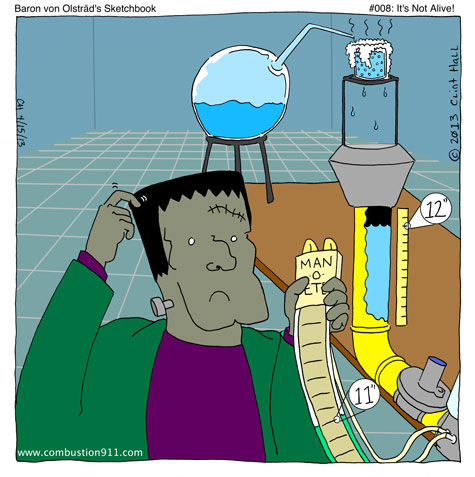It’s Not Alive
A favorite pass-time during those dark and chilly autumn evenings involves a roaring fire, a comfortable chair, a pint of robust ale, and a frightening work of fiction. One of my favorites was written by the wife of an old friend, and while the disturbing nature of the tale belies very little of the authoress's character and charm, a recent episode involving pressure brought her unfortunate antagonist to mind.
If you recall Mary's original text, then you know that Dr. Frankenstein's monster was cunning, if not practically educated. This is a detail which is omitted from much of the popular consciousness, and the poor monster is relegated to the ranks of shambling, shuffling, moaning, brainless abominations. This dichotomy rose to mind unbidden, as I considered a recent problem.
Just as the fictional Dr. Frankenstein used an opening in his roof to allow some little rain, and some massive electricity, to enter, so the modern manufactory will use such openings to allow for the ventilation of combustion byproducts. The design and installation of these flues and vents should be heavily monitored, as a single flaw can have show-stopping results. Consider the burner installed in such a way as to fire "up," toward the ceiling, with a pipe positioned above, and beyond the firing range. Supposing that there is no danger to the pipe from heat, there may still be an operational hazard to the burner due to elements of the weather traveling down the pipe, as gravity would intend.
An acquaintance of mine with a similar arrangement contacted me in a state of frenzy akin to the proverbial mad scientist, certain that one or more of his quality combustion components (supplied by the good people at Combustion 911) was faulty. He had pressure at the safety valves, 11 inches water column, but very little pressure at the burner, resulting in less-than-satisfactory heating of his product. After a lengthy conversation, I convinced my acquaintance -- no mindless brute, by any stretch – that perhaps the problem was due to a blockage in the pipe, between the burner and the regulator, with pressure exceeding that of the combustible fluid.
Perhaps grudgingly, he investigated my suggestion. What he found was a column (the gas pipe) containing 12 inches of water; one inch over the line, so to speak. Though, while his 11 inches of gas pressure would not have been sufficient to expel completely the rainwater he'd collected, it may have been enough to make the problem easier to diagnose.




